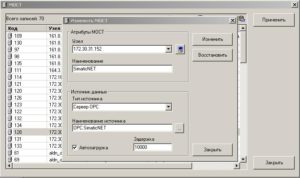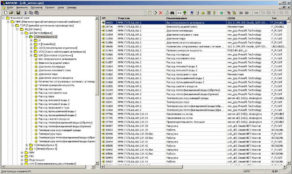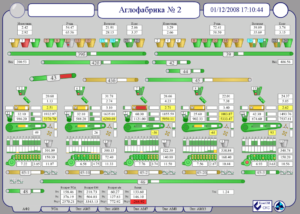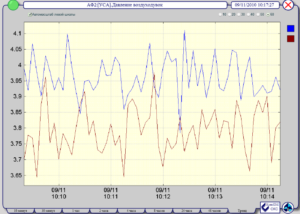PARADIGMA: Process Data Integration Package

- Description
- Components
It is not a secret that the process control level encompasses local process control systems, which can be supplied together with the equipment or they can be third-party systems. Every such system is usually a complete system that is not integrated with other process control systems. Basically, it is a local integrated software and hardware package designed for a specific application. Thus, there are systems designed for blast furnaces, rolling mills, pump stations, power stations, etc.
Today, every new line or plant has to be integrated in the existing information infrastructure of the site. The failure to do so can impede the overall process control and lead to the faulty operation of related systems as they stay ignorant about the new equipment.
Almost all automation solutions offered today support the current data exchange protocols which make it possible for the data to be transferred to the upper levels, such as MES level. However, this does not appear to be sufficient to ensure a cost-effective revamping project.
A good return on investment within the best timeframe can only be gained if one adopts a system capable of consolidating the data coming from unrelated control systems supplied by different vendors, converting the data into a single format and sending them to any other related process control systems or the MES level.
Such data consolidation provides the following benefits:
- a single point of access to all process data;
- the opportunity to build a supervisory control system that will monitor all processes and all equipment of the site;
- solutions covering a broad range of MES tasks which involve the analysis of lower level data: product quality management, maintenance management, process and energy consumption monitoring, reporting, etc.
For an integrated process data system we offer our proprietary solution – the PARADIGMA package.
Purpose
PARADIGMA is an integration platform with the key functionality of data acquisition, processing, storage and transfer (to MES).
In fact, PARADIGMA acts as a mediator between the process control level and the MES level. A change in the design or type of the existing equipment does not require any changes in the overall integration system.
Key tasks and functions
|
Key Tasks |
Key Functions |
| 1. Acquisition |
|
| 2. Processing |
|
| 3. Storage |
|
| 4. Visualization |
|
| 5. Transmission |
|
Creating a supervisory control system with PARADIGMA
With PARADIGMA we can build a supervisory control system of any size: local systems to control separate production stages, plant-level systems or central dispatch control systems.
Supervisory control systems based on PARADIGMA do real-time equipment and process monitoring, collect and utilize the energy consumption data, automatically detect failures and receive data coming from the related MES-level systems.
PARADIGMA ensures data visualization with the help of mnemocircuits which can be developed using any other software. PARADIGMA itself contains a set of Flash based data visualization solutions ensuring the Customer’s independence from the software developer.
Key Functionality and Features
- Versatility: This solution is suitable for any industry or sector.
- A single integration standard: Application of standard technology and standard data formats with a consolidated process data storage.
- Full functionality: Data acquisition, storage, processing, visualization and transmission.
- Full scalability: From local control systems to distributed systems with centralized control.
- Remote web access: The process can be monitored from any computer connected to the Internet.
- Flash based data visualization.
- Unlimited simultaneous users.
- Role-based access control with access rights defined for every workstation.
- Intuitive and user-friendly interface.
- The control system can be set to fit your organisational structure.
- No need for third-party software.
- The system can be tailored to the customer’s needs.
Some Benefits of Using PARADIGMA
- No hidden costs: One server node is enough to house the entire functionality of the system.
- Complete and reliable data available on each control object.
- Remote process control with an event-based control model.
- Comprehensive information about the equipment for informed decision-making.
- Reduced downtime and reduced maintenance costs due to early detection of potential failures.
- The availability of energy consumption analysis and equipment performance analysis.
PARADIGMA is your best choice for building a state-of-the-art integrated management system.
PARADIGMA Components
- Local data exchange server:it is an MS SQL database that stores the data necessary for the PODIUM and PILOT subsystems. Data are stored in the database with the help of a special exchange module.
- The PODIUM components include:
- Tag Processing & Aggregation Module:this Module enables the interaction between the Real-Time Data Buffering Module tags and a data source and performs the functions of reading and writing.
- Streaming Replication Module:this Module stores archive data.
- Event Processing Module:this Module processes and stores events.
- Bridge Module:this Module supports data transfers from various sources to the database.
- Real-Time Data Buffering Module:this is a RAM area that stores the current tag values. Each tag has its unique code, name, data type, unit of measure, limits, program code and a set of events it can initialize.
- The PILOT components include:
- Tag Retrieval & Display Module:this Module transfers the current and archive tag values and events to the user workstations.
- Graphic Representation Module:this is a standard flash-screen project comprising a number of versatile components and tools for the interaction with Tag Retrieval & Display Module.
- Data Exchange Module (PHARAON):this Module is responsible for data inputs, set-ups, as well as for monitoring the current tag values.




